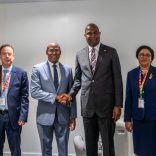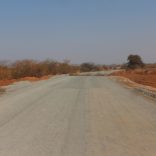Mozambique posts €300 million budget deficit in Q2, down €133.7 million YoY – government
Mozambique foresees €300B to implement ENDE, grow at almost 10% per year until 2044

File photo: Lusa
The Mozambican government has identified financing needs of €300 billion to implement the five priority pillars of the National Development Strategy (ENDE) 2025-44 and achieve the target of an almost 10% economic growth.
The document, to which Lusa had access today and which will be discussed in parliament in the coming weeks, revises upwards the needs previously identified, when the strategy was approved in June 2024, indicating at the time investment needs of €246 billion.
“It is a shared commitment to the future of the country. By implementing this strategy, Mozambique strengthens its capacity to face the challenges of the present and build a prosperous and sustainable future for all citizens,” reads the document revised by the current government led by Daniel Chapo, who took office in January as the fifth President of Mozambique.
The first version of the document was prepared before the general elections of October 9, 2024, which were followed by several months of social unrest and street protests against the electoral process, which caused around 390 deaths and had a strong impact on the Mozambican economy.
The current version of the ENDE, which recognizes these economic and social impacts of the post-election social unrest, defines the ‘Structural Transformation of the Economy’ as the pillars for the next 20 years, with investments of almost US$114 billion (€100.3 million), and ‘Social and Demographic Transformation’, with US$70.8 billion (€62.3 billion).
It also includes the pillars of Infrastructure, Organization and Territorial Planning, foreseeing investments of US$56 billion (€49.3 billion), National Unity, Peace, Security and Governance, with US$52.6 billion (€46.3 billion), and Environmental Sustainability, Climate Change and Circular Economy, with US$48.3 billion (€42.5 billion).
“Mozambique’s economic growth over the next two decades will be influenced by several factors, including the impact of oil and gas projects, structural reforms in key sectors such as agriculture, industry and services, climate events and the evolution of global macroeconomic conditions,” the document acknowledges.
The implementation of the strategy foresees an average annual growth rate of the Gross Domestic Product (GDP) of 4.6% in the period up to 2028, reaching 7.1% in the period up to the end of 2034, rising to 8.7% by 2039 and to 9.9% by 2044.
“The projections for Mozambique’s economic growth over the next 20 years (…) highlight the need for continued investment in infrastructure, industrialization and modernization of the productive sectors. While the baseline scenario foresees more moderate and gradual growth, the ENDE scenario indicates that a series of strategic reforms and the diversification of the economy can generate a substantial acceleration of economic growth,” it also reads.
It adds that “the implementation of effective public policies and the strengthening of the industrial base will be fundamental to guarantee the sustainability of growth in the long term”.
Regarding the unemployment rate, the document sets the target of increasing the current average of 18.4% to 10.5% by 2044, with a greater impact on youth unemployment, which aims to reduce from the current 33.4% to 18.6%.
The ENDE funding until 2044 will be provided by a “combination” of the State Budget, specific development funds and tax incentives and subsidies.













Leave a Reply
Be the First to Comment!
You must be logged in to post a comment.
You must be logged in to post a comment.